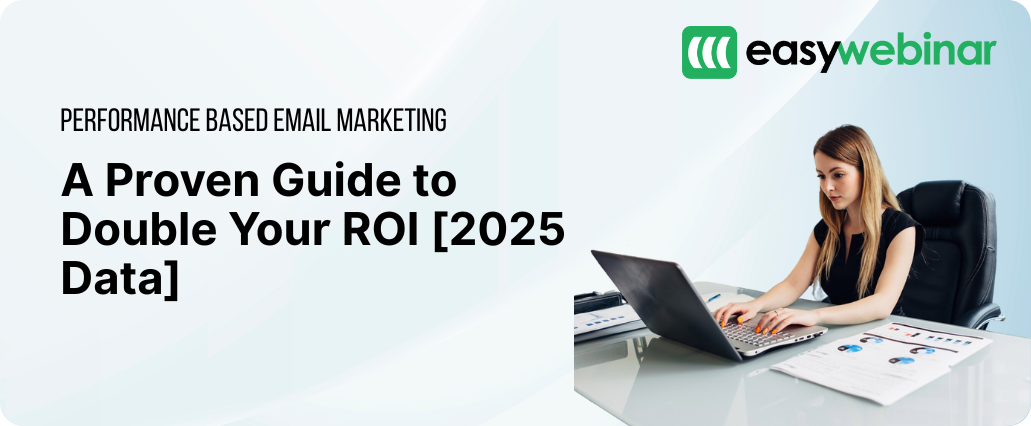Performance Based Email Marketing: A Proven Guide to Double Your ROI [2025 Data]

Summary :
Email marketing continues to outperform other digital channels, generating an impressive average ROI of $36 for every $1 spent. Yet, many marketers fail to maximize their potential due to poor tracking and ineffective strategies.
This comprehensive 2025 guide to performance-based email marketing explains how to measure ROI accurately, identify key performance metrics, and implement five proven strategies to double your returns. You’ll discover how segmentation, personalization, automation, A/B testing, and optimized timing can transform your campaigns from simple communication tools into high-performing revenue channels.
The guide also highlights how EasyWebinar enhances performance-based email marketing with audience behavior tracking, automation tags, and seamless integrations with tools like ActiveCampaign and GetResponse. By combining data-driven strategies with the right technology, you can improve conversions, boost engagement, and maximize every marketing dollar you spend.
Table of Contents
- What is performance-based email marketing?
- How to measure email marketing ROI effectively
- Key metrics that impact email marketing performance
- 5 proven strategies to double your email marketing ROI
- Using EasyWebinar to boost performance email marketing
- Conclusion
- FAQs
Email marketing consistently outperforms other digital channels with exceptional returns. Every $1 spent generates an average ROI of $36, making it maybe your most profitable marketing investment. The numbers tell the story clearly – 35% of companies get between $10 and $36 for each dollar invested, while almost one-fifth of businesses achieve an incredible 7000% ROI or higher.
These numbers look impressive, yet many marketers still can’t get the most from their email marketing efforts. The data shows that 21% of marketing leaders never track their ROI. This leaves money on the table. Results vary between average and exceptional based on strategy. Individual-specific campaigns can lead to six times more transactions. Good list segmentation can boost revenue by 760%.
This piece will help you turn your email marketing from basic communication into a revenue powerhouse. You’ll learn the best ways to measure your email marketing ROI, track the most important metrics, and put five proven strategies to work that could double your current returns.
What is performance-based email marketing?
Performance-based email marketing is different from traditional channels. It focuses on measurable results instead of just reach or visibility. Your email strategy becomes a revenue-generating system with clear, trackable outcomes rather than a simple communication tool.
Performance-based email marketing builds relationships through targeted content. It nurtures leads and pushes specific actions that add to your bottom line. You’re not just sending messages—you strategically engage subscribers to meet your business goals.
How it is different from traditional email marketing
Traditional email marketing mainly looks at reach metrics like delivery and open rates. It runs on a subscription-based model where you pay a fixed monthly fee whatever the campaign results. This standard approach doesn’t have the accountability you find in true performance models.
Performance-based email marketing structures itself around outcomes:
- Objective-focused: Starts with clear business goals like generating pipeline, acquiring customers, or increasing purchase frequency
- Action-oriented: Pushes specific conversions beyond visibility
- Results-measured: Shows genuine interest through tangible actions
Traditional marketing budgets look backward. Teams allocate funds by channel before seeing results. These budgets stay locked for the year, which limits flexibility. Performance-based email marketing ties budget to results. You invest more in what works and move money away from tactics that don’t perform.
Why ROI is the ultimate success metric
Email marketing ROI shows the revenue you generate from every dollar in your campaigns. This complete metric includes creation costs, sending expenses, list building, and other key parts of your email strategy.
Surface-level metrics like impressions only measure exposure—not effect. ROI gives solid proof that your marketing spend makes sense. Email marketing brings in $36-$40 for every dollar spent. This return beats other digital channels consistently.
Immediate performance visibility creates accountability and predictability. Modern marketing dashboards show how campaigns perform in real-time. You know exactly what works and what needs changes. This quick feedback loop turns email from a communication channel into a performance-driven revenue engine.
Tracking email marketing ROI brings several key benefits:
- Shows campaign profitability
- Enables informed optimization
- Helps allocate resources
- Proves tangible results to stakeholders
Third-party cookies are getting harder to track. This makes first-party data collection through email more valuable. Businesses must use traditional performance marketing methods in their email strategies. The focus should move beyond simple open and click metrics toward revenue-focused measurement.

How to measure email marketing ROI effectively
Smart marketers know that measuring email campaigns goes beyond basic tracking. These numbers must tie directly to your bottom line. Recent studies show that 24% of marketers struggle with measuring email ROI, ranking it among their top three challenges. Let’s break down this challenge and solve it together.
The ROI formula explained
Email marketing ROI calculation boils down to a simple formula: (Total revenue from email – Total email costs) / Total email costs = ROI. This shows how much money you make for every dollar invested in your email strategy.
To cite an instance, see how a campaign that generated $100,000 in revenue with $10,000 in expenses would calculate:
- ($100,000 – $10,000) / $10,000 = $9, or a 900% ROI
Your return equals $9 for each dollar spent. You can express this as a percentage by multiplying the result by 100, which gives you 900% ROI.
Another approach calculates revenue per email by dividing total revenue by the number of emails sent. This method helps you understand each message’s value, especially when you analyze campaigns during specific periods.
What to include in your cost calculation
ROI figures often appear inflated because marketers underestimate their true email marketing costs. Your calculations should include these key components:
- Email service provider fees: Monthly or annual subscription costs
- Team costs: Salaries or hourly rates for everyone involved in email creation
- Creative resources: Design, copywriting, and content production expenses
- Supporting technology: Email testing services, deliverability tools, and analytics platforms
- List acquisition and maintenance: Costs associated with building and cleaning your list
Marketing experts point out that overlooking these hidden costs can substantially alter your ROI measurement. These expenses, combined with staff time spent managing campaigns, represent your actual investment in email marketing performance.
Common mistakes when measuring ROI
Modern marketing complexity creates several ROI calculation pitfalls:
Oversimplified attribution models: No attribution model perfectly captures your customer’s trip. Your business might need different approaches – time-decay, linear, or last-click. Your attribution model should match how customers make their buying decisions.
Ignoring lifetime value: Businesses often focus on immediate returns instead of learning about email’s effect on customer lifetime value. This narrow view undervalues your email marketing efforts.
Incomplete tracking setup: Accurate measurement needs detailed tracking through UTM parameters and conversion tracking. Without proper systems, you’ll miss the true picture of your performance.
Not accounting for all costs: About 21% of marketing leaders never measure ROI. Others look at direct expenses but miss indirect costs like team time and creative resources.
Inconsistent measurement periods: Meaningful comparisons need consistent timeframes. Weekend campaign results won’t match a month-long initiative.
You’ll understand your email marketing’s true value by avoiding these pitfalls and setting up proper tracking. This creates the foundation for evidence-based improvements that can boost your email marketing results dramatically.
Key metrics that impact email marketing performance
Email marketers need to look beyond overall ROI. Understanding specific metrics helps you learn about what makes email campaigns successful. These indicators build the foundation of any performance-based email marketing strategy.
Open rate and click-through rate
Open rate shows what percentage of recipients open your email. This metric used to be vital but has become less reliable because of privacy changes like Apple’s Mail Privacy Protection. Industry averages range from 17-28%. Education (28.5%) and agriculture (27.3%) see the highest numbers.
Click-through rate (CTR) shows how many people clicked links in your email. This gives you better insight into engagement than just opens. The math is straightforward: (Total clicks ÷ Number of delivered emails) × 100. Average click rates run between 2-5% based on industry. Education leads with 4.4%.
Smart marketers also watch the click-to-open rate (CTOR) – clicks divided by opens. This metric reveals how engaging your content is when someone opens your email. Industry averages fall between 6-17%.
Conversion rate and revenue per email
Conversion rate tells you what percentage of recipients take your desired action after clicking. You can find it by dividing completed actions by emails delivered and multiplying by 100. This number connects email activity directly to business results, making it a vital part of performance-based strategies.
Revenue per email (RPE) reveals how much money each sent email generates on average. The calculation divides total revenue by delivered emails. This helps you compare campaigns and justify your email marketing spend.
Many successful companies now track revenue per recipient (RPR) to understand each subscriber’s value. Better segmentation strategies can boost this metric and maximize ROI substantially.
Bounce rate and unsubscribe rate
Bounce rate points to delivery issues by showing the percentage of emails that never reach inboxes. The formula works like this: (Bounced emails ÷ Total emails sent) × 100. Your target should be under 2% to keep a good sender reputation. There are two types:
- Soft bounces: Temporary issues like full inboxes
- Hard bounces: Permanent problems with invalid addresses
Unsubscribe rate measures how many people opt out of future emails. Some list churn happens naturally, but rates over 2% suggest problems with content relevance or email frequency. High unsubscribe rates often relate to other concerning metrics like lower opens, fewer clicks, and more spam complaints.
These interconnected metrics create the foundation to optimize your performance-based email marketing strategy and maximize ROI. Small improvements in each metric add up to boost overall campaign performance.

5 proven strategies to double your email marketing ROI
Your email marketing can go from good to great with proven tactics. Research shows that better targeting, personalization, and timing can increase your returns significantly. Here are five informed approaches that could double your email marketing ROI.
1. Segment your audience for better targeting
Email marketers today put segmentation at the top of their list, and with good reason, too. Messages become more relevant when you split your audience into meaningful groups. Marketers who segment their campaigns get better open rates, higher conversions, and end up with happier customers.
The numbers tell the story: segmented email campaigns bring in 760% more revenue than non-segmented ones. More than 75% of email ROI comes from segmented campaigns.
Start with these simple segmentation approaches:
- Demographic data (location, age, gender)
- Behavioral patterns (past purchases, browsing history)
- Engagement levels (active vs. inactive subscribers)
- Customer lifecycle stage (new leads vs. loyal customers)
2. Personalize content based on behavior and priorities
Personalization turns standard emails into highly relevant communications that work alongside segmentation. Your messages can appeal at an individual level when you use subscriber data. Personalized campaigns get six times higher transaction rates than generic messages.
Emails with personalized subject lines get opened 26% more often. All the same, personalization means more than just using someone’s name. Real personalization has:
- Purchase history recommendations
- Browsing behavior-based content
- Priority-based messaging
- Location-specific offers
3. Automate high-intent email workflows
You can deliver perfectly timed messages based on specific triggers through automation. These behavior-triggered emails get 5x higher open rates and 15x more clicks than standard newsletters. Automated campaigns create 37% of email sales while making up just 2% of email volume.
Focus on these high-converting workflows:
- Welcome sequences for new subscribers
- Cart abandonment reminders
- Re-engagement campaigns for inactive users
- Post-purchase follow-ups
4. A/B test subject lines and CTAs regularly
Regular A/B testing takes the guesswork out of your email strategy. You can find exactly what appeals to your audience through continuous testing. Test these elements that make a big difference:
- Subject line length and phrasing
- CTA button color, size and wording
- Email design and layout
- Copy length and tone
5. Optimize send times and mobile experience
Good timing makes a huge difference in engagement—emails sent at the right time get 33% higher transaction rates. Mobile optimization is vital since 41% of all emails are read on smartphones.
Look at when your subscribers usually engage instead of following generic best practices. Make sure your emails look perfect on mobile devices with:
- Responsive design that adapts to screen size
- Compressed images for faster loading
- Thumb-friendly buttons (at least 44x44px)
- Scannable content with clear hierarchy

Using EasyWebinar to boost performance email marketing
Specialized tools can help turn your performance-based email marketing strategy from theory into measurable success. EasyWebinar is a powerful platform that enhances marketing ROI through integrated engagement analytics, audience segmentation, and automation.
How EasyWebinar supports segmentation and automation
EasyWebinar allows you to segment your audience based on behaviors such as attendance, engagement level, and watch time. These insights trigger automated tags that sync with leading email marketing platforms like ActiveCampaign, GetResponse, Drip, and Mailchimp. This setup makes it easy to send behavior-specific follow-up messages, for example, reminding no-shows, nurturing attendees, or re-engaging early drop-offs, improving both personalization and ROI.
Integrating webinars into your email funnel
EasyWebinar’s built-in email tools manage webinar-related notifications and follow-ups with smart scheduling based on each registrant’s timeline. When you incorporate webinar content into your email marketing funnel, you create meaningful, personalized touchpoints that guide leads through your conversion journey.
Real-time engagement data to refine campaigns
The platform’s detailed analytics dashboard gives insight into attendee behavior, including poll participation, chat activity, and drop-off rates. This real-time engagement data helps marketers pinpoint what resonates most with audiences and refine email campaigns accordingly.
Conclusion
Email marketing remains the most effective digital marketing channel. The data proves this point – you can get 36 times your investment back. This makes email marketing crucial for any marketing plan that works. Yet many companies don’t realize its full potential.
You’ve learned how to turn your email campaigns from simple communication tools into profit centers. Success comes when you look beyond surface-level stats and focus on metrics that affect your revenue. A well-calculated ROI shows exactly how well your email marketing performs.
The five strategies we covered give you a clear path to better results. Breaking down your audience into segments can boost revenue by 760%. Personalized emails generate six times more transactions. The system works even better when you combine automated workflows, regular A/B testing, and perfect timing. These elements create a multiplier effect that boosts your results.
EasyWebinar makes these strategies more powerful with advanced segmentation tools, smooth automation, and detailed user behaviour tracking. The platform helps you send the right messages at the right time based on how subscribers actually behave. EasyWebinar works well with your current marketing tools through its complete integration features.
You now know how to double your email marketing ROI. Put these tested strategies to work, track your numbers carefully, and watch your results improve. Your subscribers will get better content, and your business will earn substantially more from every marketing dollar you spend on email.
FAQs
Q1. Is email marketing still effective in 2025?
Yes, email marketing remains highly effective in 2025. It consistently delivers exceptional returns, with an average ROI of $36 for every $1 spent. When implemented strategically with personalization and segmentation, email marketing continues to be one of the most profitable channels for many businesses.
Q2. How does performance-based email marketing differ from traditional email marketing?
Performance-based email marketing focuses on measurable results and specific business objectives, unlike traditional email marketing which primarily tracks reach metrics. It is action-oriented, designed to drive conversions, and evaluated through tangible actions that contribute directly to the bottom line.
Q3. What are the key metrics to track in email marketing?
Important metrics to track include open rate, click-through rate, conversion rate, revenue per email, bounce rate, and unsubscribe rate. These metrics provide insights into engagement, effectiveness, and overall campaign performance, helping marketers optimize their strategies for better results.
Q4. How can I improve my email marketing ROI?
To improve email marketing ROI, focus on audience segmentation, personalize content based on subscriber behavior and preferences, implement automated workflows, regularly A/B test elements like subject lines and CTAs, and optimize send times and mobile experience. These strategies can significantly enhance engagement and conversions.
Q5. How does EasyWebinar enhance email marketing performance?
EasyWebinar supports performance-based email marketing through advanced segmentation capabilities, seamless automation, and detailed engagement analytics. It allows for integration of webinars into email funnels, provides real-time engagement data, and offers comprehensive integration options to fit into existing marketing ecosystems, helping to amplify email marketing ROI.